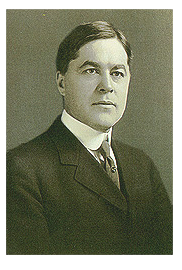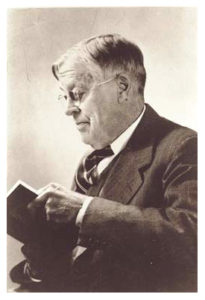
Henry Wilder Foote (February 2, 1875-August 27, 1964) was a Unitarian minister, scholar, teacher, and hymnologist. As Chair of a joint Universalist and Unitarian commission on hymnals, he oversaw the editorial compilation and production of Hymns of the Spirit (1937) which became the standard hymnbook used by both groups up to their 1961 consolidation.
He was born in Boston, Massachusetts to Frances Anne Eliot and Henry Wilder Foote. His grandfather Samuel Atkins Eliot (1798-1862) was a mayor of Boston, a Congressman, and treasurer of Harvard College while his uncle Charles William Eliot was president of Harvard, 1869-1909. His father, a graduate of Harvard Divinity School, was minister at King’s Chapel in Boston, Massachusetts for fifty-one years. His mother directed the choir at King’s Chapel for twenty years, and with her husband and others edited a hymnbook for the congregation.
After attending the Roxbury Latin School, Foote entered Harvard College where he earned an A.B. in 1897 and an A.M. in 1900. Two years later he graduated from the Harvard Divinity School with an S.T.B. Shortly after he was ordained, he was called by the First Unitarian Church, New Orleans, Louisiana. From the start, his ministry emphasized music, poetry, and art. Writing years later he insisted that the Christian minister “is called upon to create, Sunday by Sunday, a form of beauty, which though it be composed of the simplest elements, shall give expression to the mood of worship in which the congregation gathers, but which is inarticulate and inchoate until his skill shall evoke and clothe it in living speech.”
Foote married Eleanor Tyson Cope on June 22, 1903; they had five children one of whom, Arthur Foote II, became a Unitarian Universalist minister and co-editor of Hymns for the Celebration of Life (1964).
In 1906 Foote left the New Orleans parish for the First Unitarian Church, Ann Arbor, Michigan where he remained until 1910. While there, the American Unitarian Association (AUA) appointed him chair of its Commission on Hymns and Services, which under his guidance produced The New Hymn and Tune Book (1914). It also made him Secretary of its Department of Education, 1909. In 1914 he returned to Harvard Divinity School as Assistant Professor of Preaching and Parish Administration and Secretary of the Faculty. In addition, he assisted with the overall administration of the school. Foote remained at Harvard for the next decade. The essence of the courses he taught is captured in his book The Minister and His Parish: A Discussion of Problems in Church Administration (1923).
In 1924, Foote returned to parish ministry at the First Church in Belmont, Massachusetts. He held this position until his retirement in 1940. In addition to his parish duties, he served as the Executive Secretary of the arrangement committee for the 1925 AUA centenary celebration. It was also during his Belmont pastorate that he wrote several significant scholarly volumes, as well as editing a new hymnal that became for both Unitarians and Universalists their standard hymnbook for a generation. His son Arthur remembered his dedication to his chosen labors: “Night after night,” he declared, “the light burned late in his third floor study; and the mornings of his summer vacations invariably found him working in his small study on the shore at Southwest Harbor, Maine. He was a scholar by nature, willing to work long hours and to take infinite pains to get things right.”
At Harvard he had become friends with Archibald Thompson Davison, Professor of Music, organist and choirmaster for its church, and founder and first conductor of the university’s Glee Club. Working together over several years, they edited two volumes of anthems: The Concord Anthem Book (1925) and The Second Concord Anthem Book (1936).
In 1927 when the American Unitarian Association determined that the churches needed a new hymnbook, it again made Foote chair of the commission to oversee the project. Working with him was Curtis W. Reese, a leader of the Humanist wing of the denomination; Edward P. Daniels, a musician; and Von Ogden Vogt, the author of two respected books on art and worship. In 1931 when the Universalist church appointed a committee to prepare a new hymnal the two committees were merged.
With the goal that the new collection be a “broad and inclusive volume,” Foote and the other editors retained “the great hymns of the church” that were “a genuine utterance of a living faith” while accepting new hymns that celebrated modern “thought” and that congregations could actually sing. The result, after ten years of work, was Hymns of the Spirit (1937). It was warmly received by the congregations of both denominations and was not replaced until after their 1961 union.
In the 1930s, Foote was disturbed by the rise of anti-semitism and the growth of Nazism in Germany. The aim of this evil movement, he wrote, was “to drive out all Jews who can be made to pay for their escape by the sacrifice of their property and to exterminate those who cannot get away. Coming centuries will record this anti-Semitic campaign on one of the blackest and most discreditable pages of history.” His public concern was unusual in America, which preferred to ignore this threat and where anti-Semitism was too often practiced.
In 1940 when the AUA formed the Unitarian Service Committee (USC) to help save European refugees, especially Jewish ones, four of its lay leaders were drawn from Foote’s Belmont congregation. Seth Gano served as vice-chair, Edward Witte as treasurer, Robert Dexter as executive director, and his wife Elisabeth (Anthony) Dexter as European USC director.
The history and story of hymnody and those who composed hymns fascinated Foote throughout his life. When he was teaching at Harvard he prepared a paper for the Divinity School’s Visitation Day on “The Harvard School of Hymnody.” It was published in Transactions of the Unitarian Historical Society (1924), the publication of the British Unitarian Historical Society. When he discovered an old letter tucked into a Unitarian hymnbook at the Union Theological Seminary, New York that had been written by Samuel Longfellow, a noted nineteenth-century Unitarian hymn writer, he examined the other hymns by Longfellow and wrote “The Anonymous Hymns of Samuel Longfellow” for The Harvard Theological Review (1917).
The Year before Hymns of the Spirit was published, Foote was asked to give a series of lectures on American hymnody at the 1936 Harvard Summer School of Theology. The summer school was part of the Harvard Tercentenary Celebration. He eventually expanded these lectures into a comprehensive, detailed, and scholarly history of hymnody which was published by Harvard University Press as Three Centuries of American Hymnody (1936). A review in American Literature said that it “aims chiefly at apprehending those main streams of religious thought and practice which have found expression in the hymnbooks used by successive generations. It deals primarily with the words, and only incidentally with the music. In the author’s judgment, the material he presents is significant in that it gives evidence; first, of a breaking down of denominational barriers, and, second of trends toward the expression of individualistic and theologically independent religious experience on the one hand and human brotherhood (as distinct from a church universal) on the other.” Reprinted in 1968, Three Centuries of American Hymnody continues to be a reliable reference source.
When Foote turned sixty-five in 1940, he retired from active parish work and devoted his remaining years to research and writing, except for a brief pastorate in 1943-45 at the Thomas Jefferson Memorial Church, Charlottesville, Virginia. While there, he studied the religious thought of Jefferson, which resulted in several publications including Thomas Jefferson, Champion of Religious Freedom, Advocate of Christian Morals (1947). In addition to his Jefferson studies he continued his association with the Hymn Society of America serving as its president,1941-42. He also remained an active trustee of the Hampton Institute in Virginia and the Penn School of Frogmore, South Carolina. Foote served as trustee at both African-American educational establishments for more than half a century.

Retirement allowed Foote to return to his scholarly interest in early colonial painters and musicians, which he started in the 1930s when he published his research on Musical Life in Boston in the Eighteenth Century (1940) and on Jeremiah Dummer, Colonial Craftsman & Merchant (1935), which he wrote with Hermann Frederick Clarke. In 1950, the Harvard University Press issued his thoroughly researched and still highly valuable book-length investigation on John Smibert, Painter, with a Catalogue of Portraits and on Robert Feke: Colonial Portrait Painter. These were followed by significant magazine essays “Charles Bridges, Sergeant-Painter of Virginia,1735-1740” and “Benjamin Blyth of Salem: Eighteenth-century Artist.”
One of his last projects was the careful compilation of American Unitarian Hymn Writers and Hymns and Catalogue of American Universalist Hymn Writers and Hymns. Both were published in 1959 and continue to be valuable reference tools.
Twice during his life his accomplishments were recognized with honorary D.D. degrees: the Pacific Unitarian School for the Ministry, 1929 and the Meadville Theological School, 1941.
When nearing eighty, at the urging of his family, Foote wrote his last book Religion of an Enquiring Mind. In it, he described the liberal Christian faith, which shaped his living. That faith included a belief in God and an appreciation that Jesus in his teachings gave “incentives to right actions.” Central to his faith was “the free mind” that “refuses to build dams in the form of creeds or dogma in the worse than futile attempt to hold back forever the onward flow of thought through as yet undiscovered realms of human experience.” Finally, Foote believed that religion at its best represented “the common aspiration of mankind for the life of peace and good will.”
Death
After five years of decline due to minor strokes, Henry Wilder Foote died on August 27, 1964 at his beloved Southwest Harbor, Maine summer residence. “Such men as he,” observed his son Arthur, “maintain the fabric of the world, and in the handiwork of their craft is their prayer.”
Sources
The Andover-Harvard Theological Library, Harvard Divinity School, in Cambridge, Massachusetts holds the papers of Henry Wilder Foote and His Family (1714-1959) as well as his UUA Ministerial File. Publications by Foote that are not mentioned in the text include: “Remember the Days of Old: A Discourse Delivered at the 75th Anniversary of the First Church in Belmont, Massachusetts on February 8, 1931” and “Theodore Clapp: A Discourse delivered at the One Hundredth Anniversary of the First Unitarian Church of New Orleans, February 26, 1933,” in the Proceedings of the Unitarian Historical Society.
For biographical data see Arthur Foote, Henry Wilder Foote, Hymnologist (New York, 1968) and Henry Wilder Foote, “The Harvard Divinity School As I have Known It,” Publications of the Cambridge Historical Society 37 (1955-56). Also useful are articles in the 1915 General Catalogue of the Divinity School of Harvard University and Notable American Unitarians 1936-1991 (2007), ed. Herbert F. Vetter. Foote is also mentioned in the Unitarian Universalist Register-Leader (1964); the New York Times (1964) and Who Was Who in America.
Article by Alan Seaburg
Posted July 25, 2012